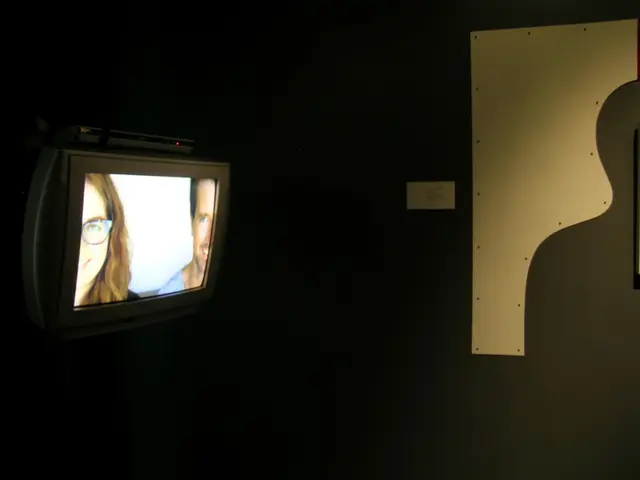“Someone looking at something”
Patrick Pound, Meredith Turnbull, Ross Coulter and Peter Tyndall
18 Sept → 10 Oct 2009
Gallery 3

Media technology has reached a point of constant influence in our lives; both technological and artistic activities have become a blurred zone of production.
How do the material qualities of new media define the psychological relationship between audience and artists? Paul Taylor suggested in the early ’80s, that it was the ‘deconstructive manoeuvre’ of photography, insinuated by both the manipulation of the ‘meaningless’ code of popular culture and the then recent psychological theories on the construction of selfhood and identity that comprised the theoretical orientation of a generation of Melbourne artists. In the same vain, each artist in someone looking at something… creates work that comments on itself and its own ‘contemporary’ reality – slyly imitating life while not pretending to recreate it, acknowledging itself as an ‘art’ object within a gallery context and engaging the viewer in a language of awareness, through their negotiation with contemporary technologies.
Contemporary artists are still dealing with similar issues concerning the introduction of photography and video, and its reproductive technologies. Terms such as ‘unique’, ‘authentic’, ‘original’ and ‘reproduction’ have been bandied around for over thirty years, but what happens now to these notions in art, when media technology reaches a point of constant influence in our lives (i.e. CCTV surveillance), the repercussions of which are so extreme as to make it difficult to separate the two – therefore technology and artistic activities also become a blurred zone of production. As the once championed media of Pop, now photography and video, when combined with the ‘rhetoric of the gaze’ becomes a highly contentious topic.
Through his discussion of the influence of the ‘rhetoric of photography’ on our history and culture, Paul Taylor disputed the concepts of the institutional ideology of art history or the museum. Taylor suggested that it was the ‘deconstructive manoeuvre’ of photography, insinuated by both the manipulation of the ‘meaningless’ code of popular culture and the then recent psychological theories on the construction of selfhood and identity that comprised the theoretical orientation of a generation of Melbourne artists.
These ideas, being just a few from the intense dialogue surrounding contemporary art of the ’80s, focused on work that commented on itself and its own ‘contemporary’ reality – slyly imitating life while not pretending to recreate it. And bathing in an odd denial of uniqueness through an apparent simplicity of everyday production (i.e. Super 8, Polaroid etc.), while still acknowledging itself as an ‘art’ object within a gallery context – engaging the viewer in a language of awareness, and challenging their experience of art.
Artists and writers from the early to mid ’80s discussed reproductive technologies as dislocations from an ‘original image’, therefore creating different contexts for a work of art. The viewer constantly needed to revisit and relocate the shifting meaning of these works and multiple existences were implied if not made actual by the necessity for the viewer to activate the work through his or her own participation. This new collaboration between viewer and artwork created a situation where the work produced was [or at least was perceived] to inevitably alter each time it was viewed.
Because the ‘rhetoric of photography’ was directed towards quotation, the process of quotation directed toward a viewer was itself dramatised. The use of captions was just one way in which artists pointed, emphasised, framed and staged their own photographic practice for the viewer and the caption embodied the involvement of the verbal within an emptied pictorial sign, becoming the supplement that directed and anchored its meaning. It directs attention and so functions metaphorically. We are now acutely aware of the affect of surveillance within the general public – how it directs and anchors the behaviour of the public in the same way a caption dictates the reaction of an audience.
What is interesting within the context of this exhibition is the influence of such technologies on the identity, communication and being of the artist and audience. How do the material qualities of new media define the psychological relationship between audience and artists? How do these interfaces effect and change us? Does it actually matter, does that guy taking money out of the bank really care? Is it just that art has been so heavily entrenched within this rhetoric of photography that we cant escape? All works within the exhibition are so critically aware of directing a persons gaze to the metaphorically ‘signified caption’ that it creates a scene in which pictures act only to illuminate the gaze, to illuminate another gaze and direct that gaze towards another piece or art commenting on ‘the gaze’.



Aotearoa/New Zealand born, Naarm/Melbourne based artist Patrick Pound is an avid collector, equally interested in systems and the ordering of objects: an attempt, perhaps, to make things coherent. As he says, ‘to collect is to gather your thoughts through things’.
Meredith Turnbull's work focuses on the potential and practical implications of the subject areas of sculpture and craft and a territory between the intimate, interior and large-scales.
Ross Coulter is an artist in Naarm/Melbourne.
Peter Tyndall is an artist in Naarm/Melbourne.